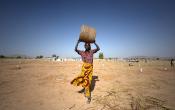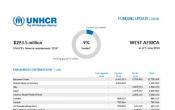Niger
Operation: Niger
Location
{"longitude":8,"latitude":18,"zoom_level":0,"iso_codes":"'NER'"}
By clicking on the icons on the map, additional information is displayed.
Key Figures
| 2017 year-end results | |
| 40% | of Nigerian refugees, IDPs and returnees were registered through biometric exercise |
| 100 | livelihood projects were supported with cash grants in Niamey |
| 49 | referrals recorded in the first six months, compared to the previous 1-2 referrals per year |
| 5 | trainings on capacity-building for 131 people (judges, journalists, members of the civil society) and on the job-training for the DRECM-Rs staff in Agadez were carried out |
| 2018 planning figures | |
| 100% | of Nigerian refugees and IDPs will be registered on an individual basis |
| 100% | of Malian refugees will be socially and economically integrated |
| 100% | of refugees and asylum-seekers identified in need of resettlement will be submitted for resettlement |
| 80% | of Nigerian households will live in adequate housing |
Latest Updates and Related Links
People of Concern
9%
Decrease in
2016
2016
| 2016 | 302,227 |
| 2015 | 332,164 |
| 2014 | 147,936 |

[["Refugees",166093],["Asylum-seekers",65],["IDPs",121391],["Others of concern",14678]]
Loading ...
Niger
< Back
2017
{"categories":[2013,2014,2015,2016,2017,2018],"budget":[56.45169034,44.15721094,49.767155435,51.18816609,82.54923247,92.78381477],"expenditure":[30.65597188,26.55522036,27.8804749,25.34641563,36.29079634,null]}
{"categories":[2013,2014,2015,2016,2017,2018],"p1":[56.45169034,44.15721094,46.858700085,46.54393827,73.06699146,80.73937398],"p2":[null,null,0.25436852,0.94422782,0.685411,0.733498],"p3":[null,null,null,null,null,null],"p4":[null,null,2.65408683,3.7,8.79683001,11.31094279]}
{"categories":[2013,2014,2015,2016,2017,2018],"p1":[30.65597188,26.55522036,25.69854914,20.99749897,28.9698051,null],"p2":[null,null,0.25079906,0.72452801,0.3408654,null],"p3":[null,null,null,null,null,null],"p4":[null,null,1.9311267,3.62438865,6.98012584,null]}
Loading ...
CHOOSE A YEAR
- 2014
- 2015
- 2016
- 2017
- 2018
Operational context
Since the arrival of the Nigerian refugees fleeing the Boko Haram conflict, the continuing insecurity in Diffa has resulted in a reduction of the absorption capacity of the host populations, as well as the capacity of the displaced population to support themselves, because of hampered basic social services in the region.Also in Tahoua and Tillabery the security situation regions continued to deteriorate and had a major impact on both Malian refugees and the local population with restrictions of movements affecting both access to basic social services and economic activities. The relocation of over 3,600 refugees from Tazalite towards Intikane in Tawa province was completed in January 2017.
The situation of refugees in mixed movements became increasingly complex, following reports on the detention conditions in Libya of illegal migrants intercepted by the Libyan guard cost. Therefore, UNHCR proposed immediate evacuation of vulnerable refugees to Niger as an emergency transit mechanism (ETM). By the end of 2017, a total of 227 vulnerable persons of concern caught in migratory flows though Libya and immediately detained in appalling conditions were evacuated from Libya to Niger to be further resettled to third countries.
Since 2016, Agadez region has seen an estimated 300,000 migrants on their way to Libya, Algeria, and onwards to the Mediterranean Sea. UNHCR, IOM and the Government of Niger signed a Memorandum of Understanding (MoU) to collectively address the issue and identify the 30 per cent of these migrants who are estimated to be asylum-seekers and refugees. To this end, UNHCR and the Regional Directorate for Civil Status, Refugees and Migration (DREC-RM) opened an office in Agadez in May 2017.
Population trends
In 2017, forced displacement affected 252,300 people of concern (PoCs) in Diffa region including some 108,500 refugees; 129,000 IDPs; and 14,800 refugee returnees.More than 56,800 refugees arrived due to conflicts in Mali and were hosted in Tillabery, Tahoua and Niamey.
The number of asylum-seekers increased within the year with the referral system in place between UNHCR and IOM in Agadez and the cases received from Libya within the framework agreement of the ETM.
Key achievements
- UNHCR intensified its efforts to identify those in need of international protection among the mixed movements. The signing of MoU with the main stakeholders on mixed movements and the development of standardized operation procedures for the identification and guidance of asylum-seekers were among the most noticeable achievements. A UNHCR Office was opened in Agadez in 2017 for a better management of the mixed refugee movements.
- A cross-regional round-table to harmonize the approach to mixed movements took place.
Unmet needs
Due to funding constraints, the following needs remained unmet:- Completion of biometric registration activities in support of the regional solution strategy for Malian refugees.
- Continued implementation of the urbanisation project in support of sustainable local integration.
- Ensuring facilitated voluntary return for all refugees opting for this durable solution.
- Provision of support to the most vulnerable Malian refugees in meeting their basic needs until the end of the year.
- Continuation of the biometric exercise for displaced population in Diffa in order to improve civil status registration and documentation.
Working environment
The protection environment in Niger is favorable, with UNHCR and authorities of Niger having developed a constructive working relationship in the search for solutions to displacement.Malian refugees are gradually being included in national structures for the provision of basic services. A pilot urbanization project that enables refugees to settle outside of camps is ongoing.
In the Diffa region, the government authorities are playing a central coordination role. They are also supporting an urbanization programme to allow refugees to gain access to land.
Regarding mixed migration, the authorities of Niger are also engaged in improving the legal framework for asylum.
Key priorities
In 2017, UNHCR's operation in Niger will focus on:• working towards “responsible disengagement” in response to the Mali situation, and transforming camps into sustainable settlements. This approach will be coupled with an effort to replace in-kind assistance with cash-based interventions and targeted assistance;
• in the Diffa situation, ensuring efficient protection monitoring, strengthening the capacity of the authorities, and reinforcing long-term interventions, through the provision of gas as well as through urbanization;
• with respect to mixed migration, ensuring that persons in need of international protection are identified and given adequate access to asylum mechanisms in Niger.
A shortfall in funding would hinder self-reliance among refugees and would preclude the inclusion of Malian refugees in local structures. Also, due to the increasing number of people in the camps, access to water will be limited, and construction undertaken as part of the urbanization project will be hampered.




